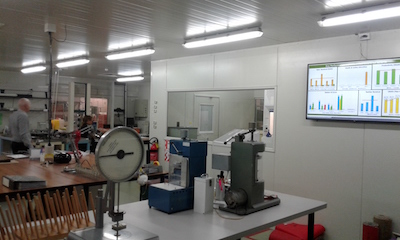Stronger customer relationships and staff engagement deliver results
Article Index

If you want to be around long term, you need to think long term. For Duane Knowles, CEO of New Zealand Wool Testing Authority, being involved in a structured productivity programme has provided fresh ideas to help his business achieve just this.
“New Zealand’s wool industry is getting smaller and our options are to shrink with it or innovate and be more clever about what we do; to be the one to lead the industry forward,” says Duane.
Given that industry leadership is woven into the Ahuriri-based business’s mission statement, there really was no option. “Driving our decision to join the programme was the desire to improve internally and bring innovation and better solutions to the industry,” says Duane.
Having completed the 12-month High Performance Work Initiative offered by Business Hawke’s Bay in partnership with Hastings District Council and co-funded through Callaghan Innovation, NZWTA has made big strides in both internal improvements and innovations to assist the industry.
Working with Smarter, Better, Faster, a local business improvement consultancy, Duane and his management team have spearheaded a number of inward and outward facing Focus Improvement Team (FIT) projects.
“One of the big realisations has been that the management team needs to not only plan for but to allocate time towards the bigger picture,” says Duane. “The bigger projects need dedication and resources outside of the normal day to day activities. It’s too easy to get caught up in the day to day, but it’s imperative to plan and perform on the larger projects.”
MyWTA, a web portal for customers to register and log into, is a “shining example” of one such project. Now customers – wool exporters, brokers and merchants NZ-wide, plus an agent in Chile, can access test results, order tests, change certification, and provide feedback directly themselves. No longer do they need to phone or email to request action.
And clients are taking action at times that has surprised the NZWTA team – like in the middle of the night or at the weekends; times when previously there would be no one at NZWTA.
Although development of MyWTA was already underway, as part of HPWI, teams were set up to drive the project with a customer service team talking directly with customers, seeking their input into what was wanted from the portal, and then checking that functionality as the development progressed.
“This process allowed us to have conversations with customers that have been so different than in the past. We’re now seen as positive and innovative, helping customers and the industry. And unlike times gone by, we weren’t ad hoc in our approach, we were disciplined with formal processes so that feedback was consistently sourced and assessed.”
More stages for the portal are planned and customers are now aware that NZWTA is receptive to meeting their needs. “It’s been hugely beneficial in generating stronger better relationships with our customers,” says Duane.
Getting staff engaged has been a key objective of the internal FIT projects. Duane acknowledges that his is a very traditional industry where change has been slow. Many of the 42 people employed over the 35 FTE positions match his own 20 years’ with the business, with some employed for even longer, and this further exacerbates resistance to change.
However, the NZWTA management group now embraces a 90-day business planning process with deliverables ticked off as a result of increased accountability. A four-year strategic plan has been broken down to annual and quarterly plans with the latter reviewed with staff monthly.
More formal performance appraisals have been introduced with the objective of getting individual staff members to be part of the firm’s development by identifying the role they can play to achieve that.
Being more transparent by sharing company performance and productivity results is another aspect introduced over the past year. Three electronic dashboards are on display setting out key information – one each in the office, textile laboratory and wool testing plant.
The large screens “tell everyone what’s going on” – from the number of tests to be done, health and safety matters, retests and errors, productivity, cash return on capital invested, and revenue generated through textile testing.
“We want everyone to know how we are performing against what we agreed we wanted to achieve,” explains Duane. “We’ve got plans to have more pages to the dashboard showing more detailed achievements and performance so we can share information and address any issues sooner than later.”
In more recent times, an Opportunities For Improvement (OFI) system has been created and implemented, with all staff able to add ideas to improve the productivity and safety of the business. A team meets regularly to assess and prioritise what OFIs can be acted on, then plans the scheduling and allocation of resources.
An unexpected bonus of participating in the HPW Initiative has been the opportunity to network with programme cohorts, says Duane. In particular, NZWTA has established a relationship with another Napier-based testing business, Analytical Research Laboratories.
“As we’re not competitors there’s been no barriers to sharing information about our respective challenges and the solutions we’ve developed; what’s worked and what hasn’t. It’s been a tangible benefit that we weren’t expecting.”
ENDS
Photo caption: Three dashboards keep NZWTA staff up to date on key performance information; this one inside the textile testing laboratory.

